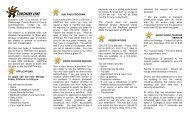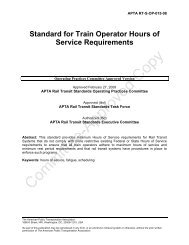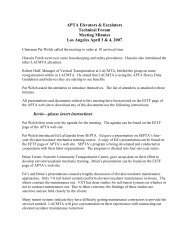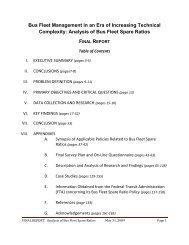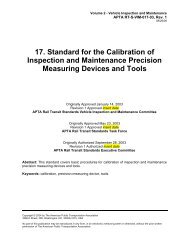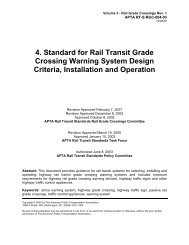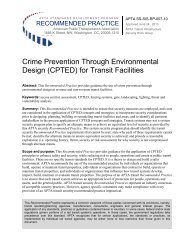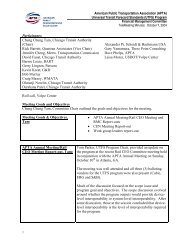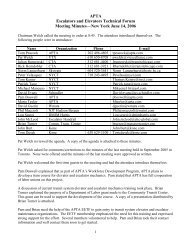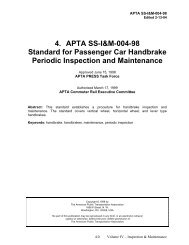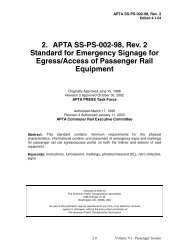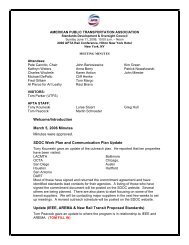Standard Bus Procurement Guidelines - APTAStandards.com
Standard Bus Procurement Guidelines - APTAStandards.com
Standard Bus Procurement Guidelines - APTAStandards.com
Create successful ePaper yourself
Turn your PDF publications into a flip-book with our unique Google optimized e-Paper software.
<strong>Standard</strong> <strong>Bus</strong> <strong>Procurement</strong> <strong>Guidelines</strong><br />
of dust and insects yet are easily removable for service. Lens shall be installed by the light manufacturer<br />
and covered with a protective material to prevent damage during assembly of the vehicle. If threaded<br />
fasteners are used they must be held captive in the lens. Access panels shall be provided to allow<br />
servicing of <strong>com</strong>ponents located behind light panels. If necessary, the entire light fixture shall be<br />
hinged. Light fixtures shall not exceed 6 feet in length.<br />
Individual ballast, providing a maximum 205-ma RMS output current, shall be provided for each light<br />
fixture. Ballast shall be non-potted, have a fireproof housing, minimum operating frequency of<br />
18,000 Hz, reverse polarity protection, integrated circuit breaker/automatic thermal protection, and<br />
rebuildable.<br />
When in the RUN and NITE/RUN mode, the first light module on each side of the coach shall<br />
automatically extinguish or dim when the front door is in the closed position and light when the door is<br />
opened. this shall be ac<strong>com</strong>plished through use of a ballast specifically designed to ac<strong>com</strong>plish this<br />
function without diminished useful fluorescent tube life. It shall be non-potted, have a fireproof housing,<br />
have minimum operating frequency of 18,000 Hz, reverse polarity protected, integrated circuit<br />
breaker/automatic thermal protection, and be rebuildable.<br />
The light system shall be designed to interlock, requiring no additional fasteners, with form part or the<br />
entire air conditioning duct. ing of identical material to provide conditioned air duct exceeding 120<br />
square inches in cross section.<br />
5.4.4.7 FARE COLLECTION<br />
Space, as far forward as practicable, and structural provisions shall be made for installation of currently<br />
available fare collection device(s). Location of the fare collection device shall not restrict traffic in the<br />
vestibule, including wheelchairs if a front door loading device is used, and shall allow the operator to<br />
easily reach the coin drop levers and to view the change platformfarebox controls and to view the fare<br />
register. The fare box shall not restrict access to the operator area and shall not restrict operation of<br />
operator controls. Location and mounting of fare collection device shall allow use, without restriction,<br />
by passengers. Fare box location shall permit accessibility to the vault for easy manual removal or<br />
attachment of suction devices. Meters and counters on the fare box shall be readable on a daily basis. A<br />
10-amp, 12-volt, DC, protected circuit shall be available to power the fare box. This power service shall<br />
include a grounded lead with both wires enclosed in a flexible conduit. The floor under the fare box<br />
shall be reinforced, as necessary, to provide a sturdy mounting platform and to prevent shaking of the<br />
fare box. The fare box, including make, model, mounting provisions, size, weight, and meter locations,<br />
is described in attachments to Part 5: Technical Specifications.<br />
Transfer mounting, cutting, and punching equipment shall be located in a position convenient to the<br />
operator. position on the right side of the instrument panel or on the fare box support. This equipment is<br />
defined in attachments to Part 5: Technical Specifications.<br />
5.4.4.8 ACCESS PANELS AND DOORS<br />
Access for maintenance and replacement of equipment shall be provided by panels and doors that appear<br />
to be an integral part of the interior. Access doors shall be hinged with gas props or over-center<br />
springs, as necessarywhere practical, to hold the doors out of the mechanic's way. Retention of all<br />
interior access panels, except on the door actuator <strong>com</strong>partments, shall be with cross-recessed head<br />
Technical Specifications 160 10/18/07



